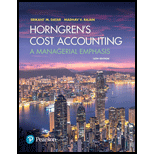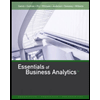
1.
Cost-Volume-Profit Analysis (CVP Analysis):
CVP Analysis is a tool of cost accounting that measures the effect of variation on operating profit and net income due to the variation in proportion of sales and product costs.
Operating Income:
Operating income is the revenue generated from the routine course of business operations. Alternatively operating income can also be referred as the earnings before interest and taxes (EBIT) which is the sum total of income after deduction of operational expenses.
To compute: Break-even point under current leasing agreement and under new commission-based agreement.
2.
To compute: Range of sales to prefer the fixed lease agreement and the commission agreement.
3.
To compute: Expected value of each agreement and decide that selection of agreement, which is better from both agreements.
Want to see the full answer?
Check out a sample textbook solution
Chapter 3 Solutions
REVEL for Horngren's Cost Accounting: A Managerial Emphasis -- Access Card (16th Edition) (What's New in Accounting)
- I need help finding the correct solution to this financial accounting problem with valid methods.arrow_forwardSolve thisarrow_forwardBetter Value Hardware began 2010 with a credit balance of $37,500 in the allowance for sales returns account. Sales and cash collections from customers during the year were $1,025,000 and $675,000, respectively. Better Value estimates that 8% of all sales will be returned. During 2010, customers returned merchandise for a credit of $31,000 to their accounts. Better Value's 2010 income statement would report net sales of _? I want answerarrow_forward
- I need help solving this General accounting question with the proper methodology.arrow_forwardA company has a net income of $645,000 and 43,000 outstanding shares. What is the earnings per share?Solve thisarrow_forwardI am looking for the correct answer to this general accounting problem using valid accounting standards.arrow_forward
- What is the correct answer with general accounting questionarrow_forwardIn joint venture accounting, the equity method requires? (a) Recognition of share of profits and net assets (b) Line-by-line consolidation (c) Cost method only (d) Fair value accountingarrow_forwardPension plan assets were $2,350 million at the beginning of the year and $2,580 million at the end of the year. At the end of the year, retiree benefits paid by the trustee were $61 millionand cash invested in the pension fund was $62 million. What was the percentage rate of return on plan assets? Problem related to accountingarrow_forward
- Principles of Accounting Volume 2AccountingISBN:9781947172609Author:OpenStaxPublisher:OpenStax College
 Cornerstones of Cost Management (Cornerstones Ser...AccountingISBN:9781305970663Author:Don R. Hansen, Maryanne M. MowenPublisher:Cengage Learning
Cornerstones of Cost Management (Cornerstones Ser...AccountingISBN:9781305970663Author:Don R. Hansen, Maryanne M. MowenPublisher:Cengage Learning Managerial Accounting: The Cornerstone of Busines...AccountingISBN:9781337115773Author:Maryanne M. Mowen, Don R. Hansen, Dan L. HeitgerPublisher:Cengage Learning
Managerial Accounting: The Cornerstone of Busines...AccountingISBN:9781337115773Author:Maryanne M. Mowen, Don R. Hansen, Dan L. HeitgerPublisher:Cengage Learning  EBK CONTEMPORARY FINANCIAL MANAGEMENTFinanceISBN:9781337514835Author:MOYERPublisher:CENGAGE LEARNING - CONSIGNMENT
EBK CONTEMPORARY FINANCIAL MANAGEMENTFinanceISBN:9781337514835Author:MOYERPublisher:CENGAGE LEARNING - CONSIGNMENT Essentials of Business Analytics (MindTap Course ...StatisticsISBN:9781305627734Author:Jeffrey D. Camm, James J. Cochran, Michael J. Fry, Jeffrey W. Ohlmann, David R. AndersonPublisher:Cengage Learning
Essentials of Business Analytics (MindTap Course ...StatisticsISBN:9781305627734Author:Jeffrey D. Camm, James J. Cochran, Michael J. Fry, Jeffrey W. Ohlmann, David R. AndersonPublisher:Cengage Learning




